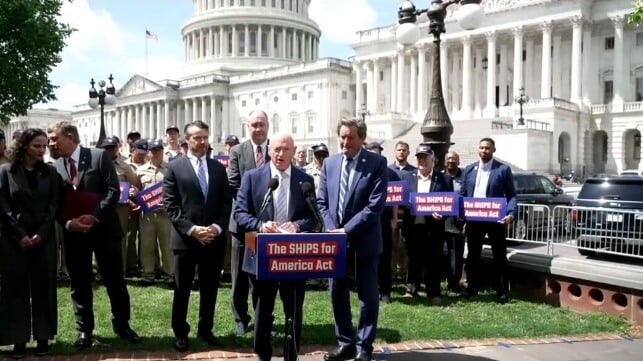Revised SHIPS Act Introduced to Revitalize U.S. Merchant Marine

A bipartisan group of U.S. Senators and Representatives reintroduced the broad SHIPS for America Act which is designed to present a comprehensive legislative approach to revitalize the U.S. merchant marine, commercial shipbuilding, and maritime industries. Elements of the legislation, which was introduced originally introduced in December 2024, have also been worked into the Executive Order on shipbuilding signed by Donald Trump earlier in April as well as the U.S. Trade Representative’s proposed fees on Chinese-built ships calling at U.S. ports.
The legislation focuses on the fact that there are currently just 80 U.S.-flagged vessels in the commercial industry while contending that China has 5,500 ships. It points to the long decline in U.S. commercial shipbuilding and problems in recruiting, training, and retention of seafarers. It calls for oversight and consistent funding of U.S. maritime policy, making U.S. ships commercially competitive which it says can be done by cutting red tape and rebuilding the U.S. shipyard industrial base. It also seeks to address the staffing challenges.
“After decades of dangerously neglecting our shipbuilding industry, we’re finally doing something about it,” said Senator Mark Kelly, a U.S. Navy veteran and the first U.S. Merchant Marine Academy graduate to serve in Congress. “The SHIPS for America Act is the most ambitious effort in a generation to revitalize the U.S. shipbuilding and commercial maritime industries and counter China’s dominance over the oceans.”
The bill calls for 250 U.S.-flagged ships within 10 years with the creation of a Strategic Commercial Fleet program. To drive this expansion of U.S. merchant shipping the act would require a portion of U.S. imports from China to be moved on U.S. flagged ships starting in 2030. The U.S. Trade Representative’s plan includes a requirement that an increasing portion of LNG exports are transported on U.S. flagged ships while the bill expands on that and adds a requirement for government-funded cargo to also move on U.S. flagged ships.
The Trade Representative is calling for fees on Chinese-built ships and operators with Chinese-built ships as well as fees on all car and vehicle carriers. The new legislation expands on that with duties on vessels owned or operated by a “country of concern,” which are identified as China as well as Russia, Iran, and North Korea. Ships from the latter countries are currently barred from U.S. ports.
Live outside the Capitol: We’re speaking about the SHIPS for America Act and how we’re going to revive American shipping and shipbuilding. Hear from me, leaders on this issue and the workers, and shipbuilders who will make this happen. ?? https://t.co/56G6Bkcp3z
— Senator Mark Kelly (@SenMarkKelly) April 30, 2025
Key elements of the proposed legislation also call for a White House-based advisor to lead an interagency Maritime Security Board and implement a National Maritime Strategy. Trump incorporated some of these concepts into his order calling for a White House office of shipbuilding.
Financing for the new fleet is addressed by establishing a Maritime Security Fund that would reinvest duties and fees as well as revising the current Title XI Federal Ship Financing Program into a revolving fund. It would also establish a 25 percent investment tax credit for shipbuilding investments. Additional financial incentives would be provided for shipbuilding and ship repair.
It calls for the creation of a U.S. Center for Maritime Innovation as well as investments in training and credential programs. It proposed streamlining and modernizing the U.S. Coast Guard credential system and making investments in the U.S. Merchant Marine Academy as well as the state-run maritime academies.
“Unfortunately, the bottom line now is America needs more ships,” said Senator Todd Young, a U.S. Naval Academy graduate and co-sponsor of the legislation. “Shipbuilding is a national security priority and a stopgap against foreign threats and coercion.”
Despite strong support, the bill failed to gain traction and issues became clouded with similar concerns to expand naval shipbuilding and to address a shortage of navy personnel and delays in warship construction. Trump’s order included a focus on issues such as the delayed frigate program and the national security cutter program for Arctic icebreakers.
Senators Kelly and Young highlighted the bill has been revised to address issues. It will now be presented in two pieces to the U.S. Senate. One piece is the SHIPS for America Act and the second element is the Building SHIPS in America Act.
Today’s announcement again garnered broad support from all sectors of the U.S. shipping industry. More than 70 organizations from all sectors of the industry are endorsing the legislation.
